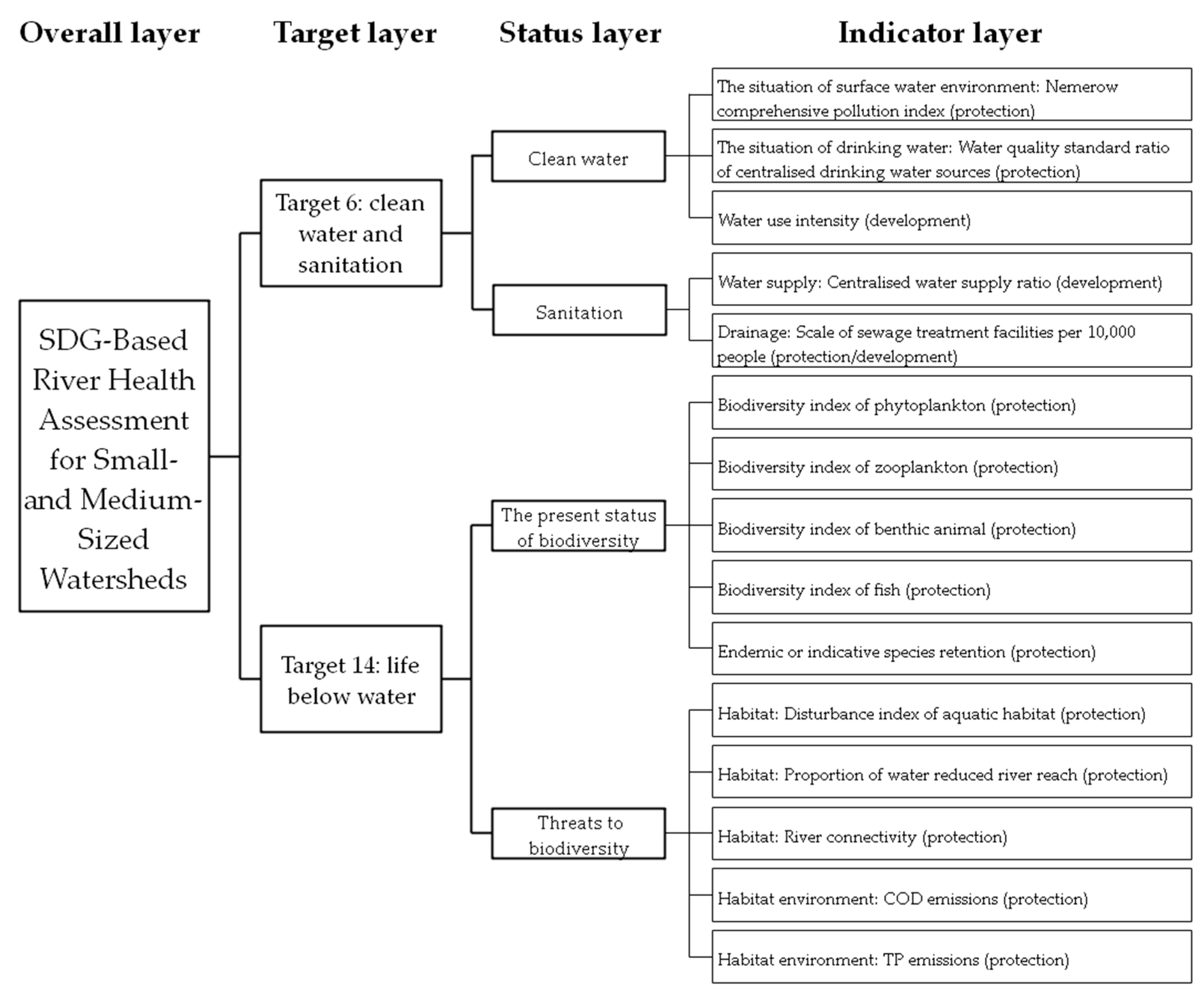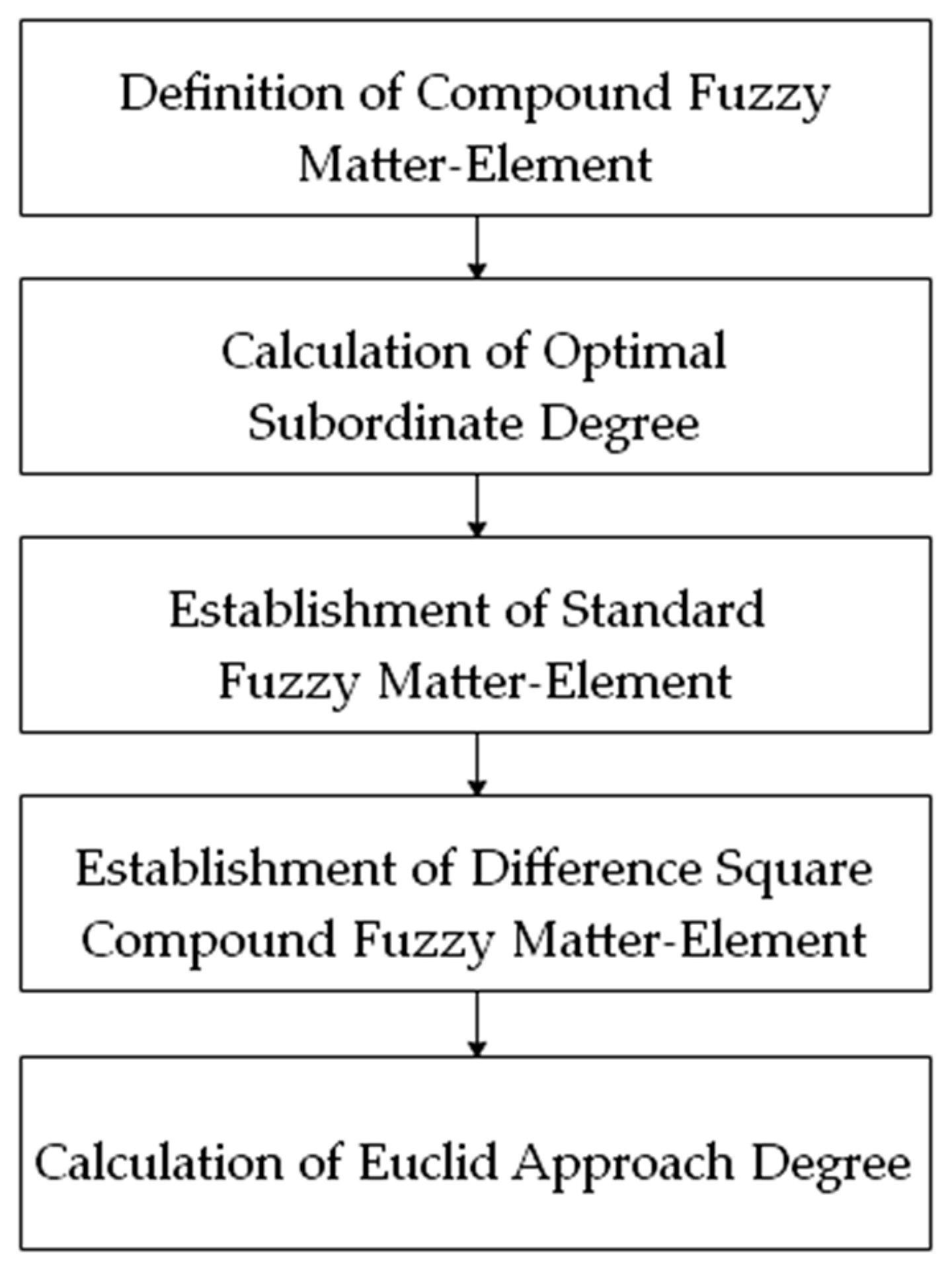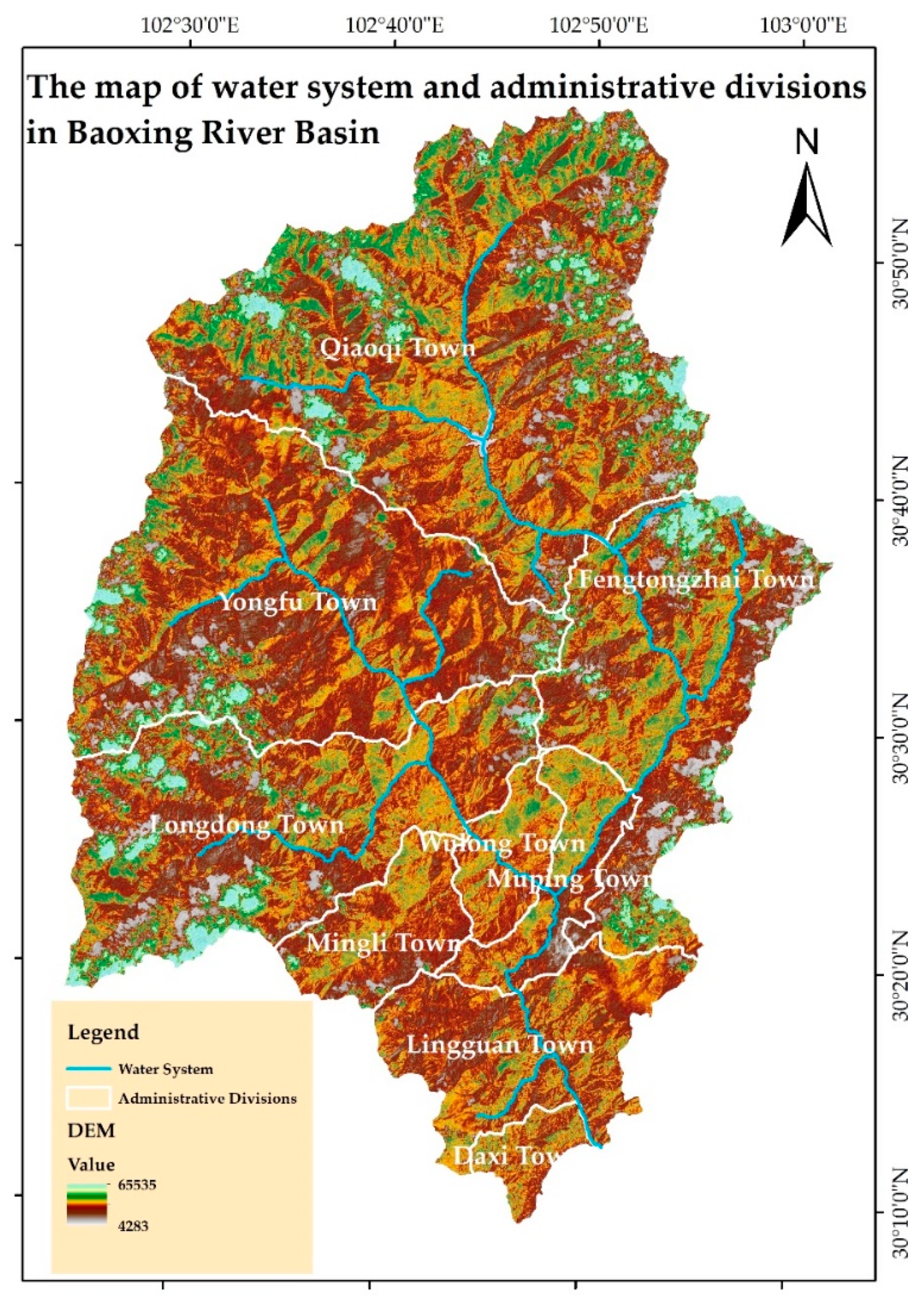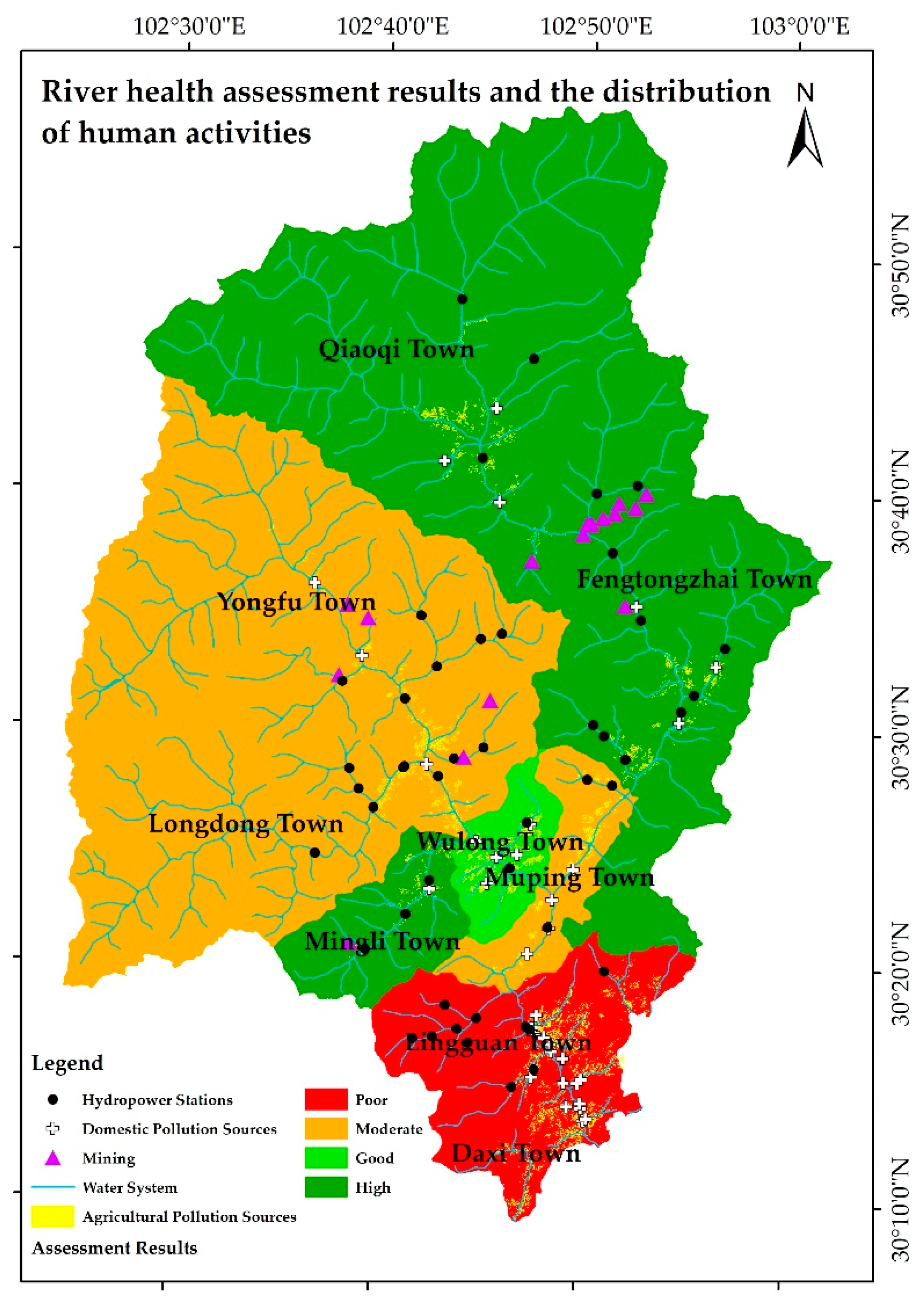SDGs-Based River Health Assessment for Small- and Medium-Sized Watersheds
Abstract
:1. Introduction
2. SDGs-Based Index System of River Health Assessment for Small- and Medium-Sized Watersheds
3. River Health Assessment Model
3.1. Determination of Combination Weight
3.1.1. Subjective Index Weighting Method Using Document Frequency Weights
3.1.2. Objective Index Weighting Method Using Entropy Weights
3.1.3. Combination Weighting Method Based on the Minimum Discrimination Information Principle
3.2. Fuzzy Matter-Element Model
3.2.1. The Concept Of Fuzzy Matter-Element
3.2.2. Calculation of Optimal Subordinate Degree
3.2.3. Construction of the Standard Fuzzy Matter-Element Matrix And the Difference Square Compound Fuzzy Matter-Element Matrix
3.2.4. Calculation of the Euclid Approach Degree and Determination of River Health Status
4. Research area and data sources
5. Result and Analysis
5.1. Results
5.2. Results Analysis and Discussion
6. Conclusions and Policy Implications
Author Contributions
Funding
Acknowledgments
Conflicts of Interest
References
- Xu, Y.P.; Li, L.G.; Cai, G.M.; Zhang, L.F.; Li, J.C. Flood Risk Map System in Medium and Small Basins in China. Sci. Geogr. Sinica 2004, 24, 452–457. [Google Scholar] [CrossRef]
- Zhou, K.; Wang, C.S. Spatial-temporal Pattern of Poverty-stricken Areas and its Differential Policies for Poverty Alleviation in China. Bull. Chin. Acad. Sci. 2016, 31, 101–111. [Google Scholar] [CrossRef]
- Jia, Y.T.; Chen, Y.F. River health assessment in a large river: Bioindicators of fish population. Ecol. Indic. 2013, 26, 24–32. [Google Scholar] [CrossRef]
- Marzin, A.; Delaigue, O.; Logez, M.; Belliard, B.; Pont, D. Uncertainty associated with river health assessment in a varying environment: The case of a predictive fish-based index in France. Ecol. Indic. 2014, 43, 195–204. [Google Scholar] [CrossRef]
- Meng, W.; Zhang, N.; Zhang, Y.; Zhang, B.H. Integrated assessment of river health based on water quality, aquatic life and physical habitat. J. Environ. Sci. 2009, 21, 1017–1027. [Google Scholar] [CrossRef]
- Zhu, W.H.; Cao, G.L.; Li, Y.; Xu, W.L.; Shi, M.; Qin, L. Research on the health assessment of river ecosystem in the area of Tumen River Basin. Acta Ecol. Sinica 2014, 34, 3969–3977. [Google Scholar] [CrossRef]
- Robert, C.; Petersen, J.R. The RCE: A riparian, channel, and environmental inventory for small streams in the agricultural landscape. Freshw. Biol. 1992, 27, 295–306. [Google Scholar] [CrossRef]
- Ladson, A.R.; White, L.J.; Doolan, J.A.; Finlayson, B.L.; Hart, B.T.; Lake, P.S.; Tilleard, J.W. Development and Testing of an Index of Stream Condition for Waterway Management in Australia. Freshw. Biol. 1999, 41, 453–468. [Google Scholar] [CrossRef]
- Sun, X.L.; Hu, C.H. Review on river health connotation and assessment method. J. Sediment. Res. 2007, 5, 74–81. [Google Scholar] [CrossRef]
- Zhao, Y.W.; Yang, Z.F. Preliminary study on assessment of urban river ecosystem health. Adv Inn. Water Sci. 2005, 16, 349–355. [Google Scholar] [CrossRef]
- Lin, M.L.; Li, X.Y.; Yang, M.H. Probe into the Index System for Evaluating the Health of the Rivers in the Pearl River Basin. Pearl. River 2006, 4, 13–14. [Google Scholar] [CrossRef]
- Abdinur, A.J.; Khaldoon, A.M. Water Services Sustainability: Institutional Arrangements and Shared Responsibilities. Sustainability 2019, 11, 916. [Google Scholar] [CrossRef] [Green Version]
- Todeschini, S.; Papiri, S.; Ciaponi, C. Placement strategies and cumulative effects of wet-weather control practices for intermunicipal sewerage systems. Water Resour. Manag. 2018, 32, 2885–2900. [Google Scholar] [CrossRef]
- Todeschini, S.; Papiri, S.; Sconfietti, R. Impact assessment of urban wet-weather sewer discharges on the Vernavola river (Northern Italy). Civ. Eng. Environ. Syst. 2011, 28, 209–229. [Google Scholar] [CrossRef]
- Munyika, S.; Kongo, V.; Kimwaga, R. River health assessment using macroinvertebrates and water quality parameters: A case of the Orange River in Namibia. Phys. Chem. Earth 2014, 76–78, 140–148. [Google Scholar] [CrossRef]
- Xiong, W.; Huang, S.P.; Yang, X. Research on key evaluation indexes of healthy river ecological system. Yangtze. River 2010, 41, 7–12. [Google Scholar] [CrossRef]
- Shan, C.J.; Dong, Z.C.; Fan, K.M.; Yang, J.H.; Liu, C.; Fang, Q. Application of combination weighting method to weight calculation in river health evaluation. J. Hohai. Univ. (Nat. Sci.) 2012, 40, 622–628. [Google Scholar] [CrossRef]
- Nemerow, N.L. Scientific stream Pollution Analysis; Scripta Book Company: Washington, DC, USA, 1974; pp. 210–230. [Google Scholar]
- Zhong, Z.; Liu, M.J.; Luo, C.; Xie, C.H. Ship-bridge collision risk assessment based on the combined weights and matter element model. J. Saf. Environ. 2018, 18, 423–428. [Google Scholar] [CrossRef]
- Du, X.J.; Yang, Z.J.; Li, G.F.; Jia, Y.H.; Chen, C. Remaining useful life assessment of machine tools based on AHP method and Euclid approach degree. In Proceedings of the 2016 International Conference on System Reliability and Science (ICSRS), Paris, France, 15–18 November 2017; pp. 46–52. [Google Scholar] [CrossRef]
- Li, T.Y.; Dong, Z.C.; Han, R. Ecological health assessment of Heilongjiang River basin based on fuzzy matter element method. Yangtze River 2017, 48, 40–44. [Google Scholar] [CrossRef]
- Xiao, Q.; He, R.C.; Ma, C.X.; Zhang, W. Evaluation of urban taxi-carpooling matching schemes based on entropy weight fuzzy matter-element. Appl. Soft. Comput. J. 2019, 81, 105493. [Google Scholar] [CrossRef]
- Guo, Y.T.; Xu, J.G. Coupling coordination measurement of urbanization and eco-environment system in Huaihe River Basin of China based on fuzzy matter element theory. Chin. J. Appl. Ecol. 2013, 24, 1244–1252. [Google Scholar] [CrossRef]
- Liu, D.J.; Zou, Z.H. Water quality evaluation based on improved fuzzy matter-element method. J. Environ. Sci. 2012, 24, 1210–1216. [Google Scholar] [CrossRef]
- Ni, J.; Liu, Z.Q.; Wang, P. Comprehensive Evaluation of Advanced Public Transportation System Based on the Matter Element and Combination Weight. Appl. Mech. Mater. 2014, 694, 26–29. [Google Scholar] [CrossRef]
- Chen, K.W.; Zhang, Z.P.; Long, J.; Zhang, H. Turning from TF-IDF to TF-IGM for term weighting in text classification. Expert Syst. Appl. 2016, 66, 245–260. [Google Scholar] [CrossRef]
- Ji, Y.; Huang, G.H.; Sun, W. Risk assessment of hydropower stations through an integrated fuzzy entropy-weight multiple criteria decision making method: A case study of the Xiangxi River. Expert Syst. Appl. 2015, 42, 5380–5389. [Google Scholar] [CrossRef]
- Zhang, Y.H.; Lu, H.P.; Luo, S.X.; Sun, Z.Y.; Qu, W.C. Human-Scale Sustainability Assessment of Urban Intersections Based upon Multi-Source Big Data. Sustainability 2017, 9, 1148. [Google Scholar] [CrossRef] [Green Version]
- Zhang, Q.Z.; Wei, H.Y.; Zhao, Z.F.; Liu, J.; Ran, Q.; Yu, J.H.; Gu, W. Optimization of the Fuzzy Matter Element Method for Predicting Species Suitability Distribution Based on Environmental Data. Sustainability 2018, 10, 3444. [Google Scholar] [CrossRef] [Green Version]
- Wang, Q.; Li, S.Q. Shale gas industry sustainability assessment based on WSR methodology and fuzzy matter-element extension model: The case study of China. J. Clean. Prod. 2019, 226, 336–348. [Google Scholar] [CrossRef]
- Jing, X.; Liu, Y.Y.; Xu, S.G.; Qi, W. A Gateway to Successful River Restorations: A Pre-Assessment Framework on the River Ecosystem in Northeast China. Sustainability 2018, 10, 1029. [Google Scholar] [CrossRef] [Green Version]
- North, M.A. A Method for Implementing a Statistically Significant Number of Data Classes in the Jenks Algorithm. In Proceedings of the 2009 Sixth International Conference on Fuzzy Systems and Knowledge Discovery, Tianjin, China, 14–16 August 2009; pp. 35–38. [Google Scholar] [CrossRef]




| Target | Status | Indicator | The Specific Meaning of Each Indicator | The Correlation with SDGs (Protection/Development) | Indicator Direction |
|---|---|---|---|---|---|
| Target 6: clean water and sanitation | Clean water | Nemerow comprehensive pollution index | The water environmental quality of the monitoring section is evaluated according to various chemical monitoring indicators, and the calculation formula is: , where: In the formula, is the Nemerow index; is the maximum value of the pollution index in all evaluation factors; is the average value of the pollution index in all evaluation factors; is the pollution index of factor i; is the monitoring value of factor i; is the water quality standard value of factor i. The target water quality of Baoxing River is class II standard. | The larger the value, the lower the degree of protection, which is not conducive to sustainable development. | − |
| Water quality standard ratio of centralised drinking water sources | The proportion of the water intake of the centralised drinking water source in the assessment area that conforms to the drinking water quality (class I standard) to the total water intake. | The larger the value, the higher the degree of protection, which is conducive to sustainable development. | + | ||
| Water use intensity | The ratio is obtained by dividing the annual water withdrawal by the total annual renewable water resources. According to international practice, it is generally considered that the water use intensity cannot exceed 40%. | Under the premise of not exceeding the utilisation limit, the larger the value, the higher the degree of development, which is conducive to sustainable development. | + | ||
| Sanitation | Centralised water supply ratio | The proportion of the population supplied by the centralised water supply project to the regional population. An indicator of water quality from the perspective of water supply sanitation facilities. | The larger the value, the higher the degree of development, which is conducive to sustainable development. | + | |
| Scale of sewage treatment facilities per 10,000 people | The ratio of the total scale of sewage treatment facilities to the total population in the region, which is used to evaluate the regional sewage treatment capacity. An indicator of water quality from the perspective of drainage sanitation facilities. | The larger the value, the higher the degree of protection and development, which is conducive to sustainable development. | + | ||
| Target 14: life below water | The present status of biodiversity | Biodiversity index of phytoplankton | Shannon-Wiener index is used to characterise the biodiversity of phytoplankton in the river. The larger the index, the higher the complexity of the community. , where represents the number of individuals of the species i, represents the total number of individuals of all species in the community. | The larger the value, the higher the degree of protection, which is conducive to sustainable development. | + |
| Biodiversity index of zooplankton | Shannon-Wiener index is used to characterise the biodiversity of zooplankton in the river. The larger the index, the higher the complexity of the community. | The larger the value, the higher the degree of protection, which is conducive to sustainable development. | + | ||
| Biodiversity index of benthic animal | Shannon-Wiener index is used to characterise the biodiversity of benthic animals in the river. The larger the index, the higher the complexity of the community. | The larger the value, the higher the degree of protection, which is conducive to sustainable development. | + | ||
| Biodiversity index of fish | Shannon-Wiener index is used to characterise the biodiversity of fish in the river. The larger the index, the higher the complexity of the community. | The larger the value, the higher the degree of protection, which is conducive to sustainable development. | + | ||
| Endemic or indicative species retention | This indicator reflects the protection extent of river endemic, indicative species and endangered species. According to the data obtained from the water biology survey or questionnaire statistics, and compared with the historical information, the value is calculated by the grading assignment method (the full score of 100). | The larger the value, the higher the degree of protection, which is conducive to sustainable development. | + | ||
| Threats to biodiversity | Disturbance index of aquatic habitat | This indicator reflects the impact of human activities such as sand digging and shipping on water habitat. When there is an invasive phenomenon of alien species in the water ecosystem, it is necessary to add the assessment of the invasive ratio of alien species. Based on the data obtained from the field survey, the value is calculated by the grading assignment method (the full score of 100). | The larger the value, the higher the degree of protection, which is conducive to sustainable development. | + | |
| Proportion of water reduced river reach | This indicator reflects the proportion of the length of the water reducing reach to the total length of the river in the assessment area, the higher the value, the greater the damage to the habitat of aquatic organisms. | The larger the value, the lower the degree of protection, which is not conducive to sustainable development. | − | ||
| River connectivity | Due to the interference of human activities, especially the construction of hydropower stations, dams and other water conservancy projects, the continuity of the river between upstream and downstream is interrupted, which has a negative impact on its self-purification capacity and biological migration channel. This indicator uses the number of dams per 100 km of river to evaluate the connectivity of the river. | The larger the value, the lower the degree of protection, which is not conducive to sustainable development. | − | ||
| COD emissions | COD is generally used to indicate the content of organic matter in wastewater, which reflects the pollution degree of organic matter in water. The higher the COD value, the heavier the organic pollutant pollution in the water, and the greater the threat to underwater life. | The larger the value, the lower the degree of protection, which is not conducive to sustainable development. | − | ||
| TP emissions | This indicator characterises the degree of eutrophication of water bodies. The higher the value, the more serious the impact on underwater organisms. | The larger the value, the lower the degree of protection, which is not conducive to sustainable development. | − |
| Town | Muping Town | Lingguan Town | Longdong Town | Fengtongzhai Town | Qiaoqi Town | Yongfu Town | Mingli Town | Wulong Town | Daxi Town | |
|---|---|---|---|---|---|---|---|---|---|---|
| Indicator | ||||||||||
| Nemerow comprehensive pollution index | 0.61568 | 1.03069 | 0.57797 | 0.51569 | 0.56892 | 0.95416 | 0.34177 | 0.60711 | 0.61513 | |
| Water quality standard ratio of Centralised drinking water sources (%) | 100 | 100 | 100 | 100 | 100 | 100 | 100 | 100 | 100 | |
| Water use intensity (%) | 0.02000 | 0.27690 | 0.63310 | 0.05620 | 0.07040 | 0.03260 | 0.08310 | 0.19470 | 0.00070 | |
| Centralised water supply ratio (%) | 1.00000 | 0.94476 | 0.40341 | 0.66143 | 0.22055 | 0.39707 | 0.13864 | 0.62914 | 0.31830 | |
| Scale of sewage treatment facilities per 10,000 people (m3/d) | 2641.73096 | 2217.40580 | 189.57346 | 516.74246 | 845.43282 | 1306.16510 | 962.77279 | 496.68874 | 530.50398 | |
| Biodiversity index of phytoplankton | 0.01100 | 0.01700 | 0.03000 | 0.02000 | 0.05800 | 0.02200 | 0.06000 | 0.02800 | 0.01700 | |
| Biodiversity index of zooplankton | 0.00000 | 0.00000 | 0.32500 | 0.69300 | 0.95200 | 0.63700 | 0.00000 | 0.00000 | 0.00000 | |
| Biodiversity index of benthic animal | 0.67300 | 0.45800 | 0.00000 | 1.63700 | 0.38500 | 0.95600 | 0.56200 | 0.45100 | 0.45800 | |
| Biodiversity index of fish | 2.48491 | 1.38629 | 1.79176 | 2.48491 | 1.79176 | 1.38629 | 2.19722 | 2.19722 | 0.69315 | |
| Endemic or indicative species retention | 62.00000 | 52.00000 | 38.00000 | 58.00000 | 68.00000 | 75.00000 | 55.00000 | 49.00000 | 85.00000 | |
| Disturbance index of aquatic habitat | 100.00000 | 86.00000 | 88.00000 | 91.20000 | 100.00000 | 100.00000 | 100.00000 | 90.00000 | 100.00000 | |
| Proportion of water reduced river reach (%) | 0.87964 | 0.14115 | 0.13978 | 0.33442 | 0.03380 | 0.05062 | 0.09849 | 0.54810 | 0.41629 | |
| River connectivity (pcs/100km) | 15.60000 | 30.20000 | 52.60000 | 20.50000 | 3.30000 | 4.60000 | 15.80000 | 18.20000 | 0.00000 | |
| COD emissions (t/a) | 84.55194 | 243.68873 | 25.16305 | 13.68964 | 43.84733 | 13.40036 | 16.77631 | 24.78215 | 17.97967 | |
| TP emissions (t/a) | 0.79146 | 2.32724 | 0.18981 | 0.06512 | 0.38515 | 0.10964 | 0.13594 | 0.19378 | 0.14918 | |
| Indicator | Number of Articles Retrieved | |||
|---|---|---|---|---|
| Nemerow comprehensive pollution index () | 4797 | 0.02547 | 0.05855 | 0.02547 |
| Water use intensity () | 31130 | 0.16529 | 0.08179 | 0.16529 |
| Centralised water supply ratio () | 1295 | 0.00688 | 0.08169 | 0.00688 |
| Scale of sewage treatment facilities per 10,000 people () | 2810 | 0.01492 | 0.08211 | 0.01492 |
| Biodiversity index of phytoplankton () | 15619 | 0.08293 | 0.09134 | 0.08293 |
| Biodiversity index of zooplankton () | 11836 | 0.06285 | 0.12239 | 0.06285 |
| Biodiversity index of benthic animal () | 10671 | 0.05666 | 0.05378 | 0.05666 |
| Biodiversity index of fish () | 51616 | 0.27406 | 0.06012 | 0.27406 |
| Endemic or indicative species retention () | 24388 | 0.12949 | 0.05807 | 0.12949 |
| Disturbance index of aquatic habitat () | 8569 | 0.04550 | 0.10057 | 0.04550 |
| Proportion of water reduced river reach () | 743 | 0.00395 | 0.05819 | 0.00395 |
| River connectivity () | 1920 | 0.01019 | 0.05102 | 0.01019 |
| COD emissions () | 20753 | 0.11019 | 0.05048 | 0.11019 |
| TP emissions () | 2188 | 0.01162 | 0.04990 | 0.01162 |
© 2020 by the authors. Licensee MDPI, Basel, Switzerland. This article is an open access article distributed under the terms and conditions of the Creative Commons Attribution (CC BY) license (http://creativecommons.org/licenses/by/4.0/).
Share and Cite
Xue, C.; Shao, C.; Chen, S. SDGs-Based River Health Assessment for Small- and Medium-Sized Watersheds. Sustainability 2020, 12, 1846. https://doi.org/10.3390/su12051846
Xue C, Shao C, Chen S. SDGs-Based River Health Assessment for Small- and Medium-Sized Watersheds. Sustainability. 2020; 12(5):1846. https://doi.org/10.3390/su12051846
Chicago/Turabian StyleXue, Chenyang, Chaofeng Shao, and Sihan Chen. 2020. "SDGs-Based River Health Assessment for Small- and Medium-Sized Watersheds" Sustainability 12, no. 5: 1846. https://doi.org/10.3390/su12051846





